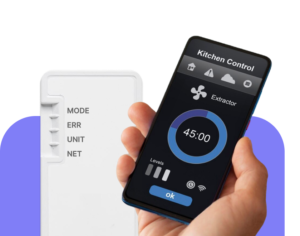IoT and HVAC: How Connected Systems are Revolutionizing Climate Control

The Evolution of HVAC Through IoT
IoT technology is transforming how we think about HVAC (Heating, Ventilation, and Air Conditioning) systems. IoT-powered HVAC systems rely on connected sensors and real-time data. They boost energy efficiency, cut costs, and support healthier indoor air quality. In today’s smart buildings, IoT-based HVAC solutions are not just optional but essential for sustainable, cost-effective climate control.
How IoT is Changing Climate Сontrol Systems
- Enhanced Monitoring and Control: IoT sensors allow for real-time monitoring of temperature, humidity, airflow, and other key parameters. This granular data enables precise adjustments, optimizing HVAC performance and ensuring consistent comfort.
- Predictive Maintenance: One of the biggest advantages of IoT in HVAC is predictive maintenance. Connected sensors can detect potential issues before they cause system breakdowns. By using predictive analytics, HVAC systems can alert maintenance teams about necessary repairs, reducing unexpected downtime.
- Energy Efficiency and Cost Savings: HVAC systems are notorious for consuming large amounts of energy. IoT enables adaptive control mechanisms that adjust based on occupancy, outdoor weather, and energy usage patterns. This can reduce energy consumption significantly, leading to cost savings and reduced environmental impact.
- Remote Access and Control: IoT-enabled HVAC systems let managers adjust settings, resolve issues, and monitor conditions from a distance. This proves especially valuable for facilities with multiple buildings or remote equipment.
Key Technologies Driving IoT in HVAC
- &lt;b>Smart Sensors: Sensors measure temperature, humidity, occupancy, and even CO₂ levels, providing the data needed for intelligent control and energy optimization.</li></li>
- &lt;b>Machine Learning and AI:e=”font-weight: 400;”> Advanced HVAC systems use AI to analyze data, learning from usage patterns to make automatic adjustments, predict maintenance needs, and continuously improve system efficiency.</li></li>
- &lt;b>Cloud-Based Platforms:“font-weight: 400;”> By storing data in the cloud, Heating, Ventilation, and Air Conditioning platforms provide a unified view of HVAC operations across multiple locations, making it easier to manage and optimize large-scale systems.</li></li>
- &lt;b>Mobile and Web Applications:style=”font-weight: 400;”> User-friendly apps enable remote access and control, allowing facilities teams and even residents to adjust settings conveniently from a smartphone or computer.</li></li>
Applications of IoT-Enabled HVAC Systems
- &lt;b>Commercial Buildings: Large facilities can reduce energy costs by using IoT-based HVAC solutions to control climate based on real-time occupancy and external conditions.</li></li>
- &lt;b>Residential Smart Homes:e=”font-weight: 400;”> IoT offers residential users intelligent thermostats and air quality sensors, which adapt to their preferences and schedules, providing comfort and cost savings.</li></li>
- &lt;b>Industrial Environments:e=”font-weight: 400;”> In warehouses, data centers, and manufacturing plants, IoT-enabled HVAC systems ensure proper climate control to protect sensitive equipment and maintain optimal working conditions.</li></li>
Fordewind’s HVAC Telematics and Telemetry System: A Real-World Innovation

A notable example of IoT’s transformative impact on HVAC is Fordewind’s HVAC Telematics and Telemetry System. This system delivers reliable, low-latency communication using cellular networks such as 2G, LTE-M, and NB-IoT. It maintains seamless performance even in tough network conditions. The system supports various Heating, Ventilation, and Air Conditioning (HVAC) equipment types. It enables real-time monitoring, remote diagnostics, and secure firmware updates.
Efficient data aggregation helps reduce operational costs.
Built on AWS cloud infrastructure, it ensures sustainable and efficient HVAC management.
This setup shows how IoT improves energy use and operational control in real environments.
The Future of HVAC is IoT-Enabled
IoT is revolutionizing HVAC systems, transforming them into intelligent, adaptable components of the smart building ecosystem. rt=”127″ data-end=”142″>>As a result, these systems are becoming more responsive and efficient. >With ongoing advancements in technology, IoT-powered Heating, Ventilation, and Air Conditioning solutions will help make buildings more energy-efficient, comfortable, and sustainable. Ultimately, they will drive climate control toward a greener, more connected future.